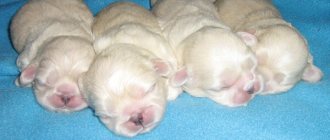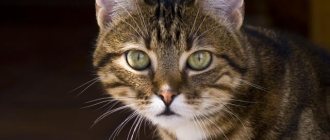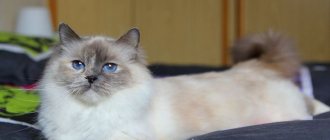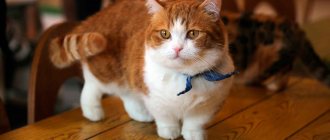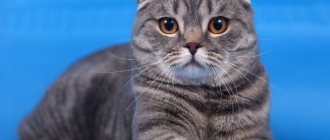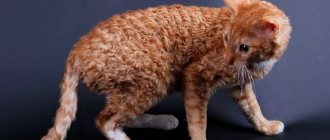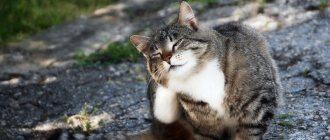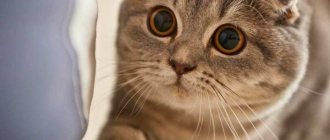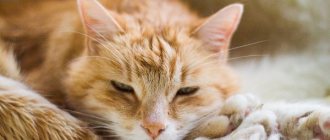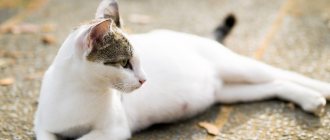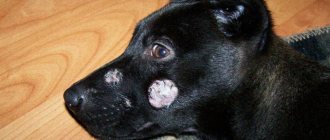In order for a cat to quickly return to normal after giving birth, complete care is necessary. It is up to you to create a comfortable atmosphere and provide your pet with everything she needs.
After giving birth, carefully monitor the cat’s condition: feel her stomach to make sure that all kittens have been born, measure her temperature (above 39 or below 37 is a good reason to call the veterinarian). In the future, you need daily monitoring of your physical condition: excessive bloody or mucous discharge, convulsions, restless behavior, intermittent breathing, poor coordination of movements - such symptoms should alert you, call a specialist as soon as possible.
What should a cat normally do?
If everything is fine with the animal after giving birth, it will definitely take care of the offspring that are born: the cat’s task is to remove the remnants of the placenta from the kittens, lick them and push them in the direction of the nipples.
First, your pet thoroughly licks her babies , first of all freeing their eyes and nose from the mucus that got there during the birth process. After this, the animal takes the umbilical cord into its mouth and, chewing it (at the same time, the umbilical cord is effectively crushed), chews it. In addition, “experienced” women in labor carefully lick the umbilical area: the saliva that gets into the wound, rich in antibacterial substances, prevents the development of inflammation.
Finally, the cat carefully and diligently licks the anal area of each kitten individually . She does this for the effective removal of original feces. If the babies are not very “smart,” your pet will definitely push them towards the nipples . It is interesting that breeders have long made a simple and logical conclusion: kittens that “without prodding” accurately determine the direction of the “milk fountains” are 100% likely to grow up to be the largest and physically strongest.
However, after the first birth, this rule does not always work: the young mother is so stunned by what is happening that she can spin and jump all over the basket. How can kittens figure out which direction to crawl?
Note that cats constantly nurse their babies for about an hour or two from the moment the latter is born. Since their eyes begin to open somewhere towards the end of the first week, the mother deliberately lies sideways to her babies so that they can always find nipples with milk. If your pet exhibits restless behavior and cannot calm down, forcefully put it down.
- After about two weeks, the cat no longer “indulges” the cubs so much, and only lies down to feed when they all start poking at her stomach at once.
- Starting from the age of four or five weeks, when the offspring have long and sharp teeth, the mother increasingly refuses to feed them and runs away, sometimes hissing indignantly.
- By eight weeks, kittens can be completely weaned and finally transferred to “adult” food.
Be sure to watch whether the cat licks the genital area of newborn kittens: for about three days, the instincts that promote natural bowel and bladder emptying do not work in babies, and therefore the mother must induce these processes artificially.
And she also has the unpleasant responsibility of eating all the excreted feces and urine (natural expediency - so that there is no smell of anything around the den). However, in practice such care often lasts much longer than three days, and the cat stops licking the “private” areas of her kittens only after the babies themselves can crawl outside the place of their birth.
Please note that the strange behavior of a cat after giving birth, when the new mother refuses to care for and feed the kittens, is often due to her poor health. It is possible that the animal suffered serious injury to its internal organs during birth, so we would strongly advise that you show the cat to an experienced veterinarian.
Dangerous postpartum hemorrhage
If postpartum bleeding turns yellowish, gray or cloudy green, then this indicates an inflammatory process of the uterus or its walls. Such manifestations can lead to the death of your pet, so you cannot do nothing. If the diagnosis shows that the lesions are serious, then the cat will have the uterus removed.
Symptoms of acute inflammation:
- increased body temperature;
- apathy and lethargy;
- abandonment of offspring;
- complete loss of appetite.
Complications immediately after childbirth can lead to the development of dangerous diseases. This could be pyometra or endometritis. With the latter, the cat screams loudly, arches its back and tries to sit up. In case of illness, kittens are taken from their mother and fed artificially.
You should also not ignore discharge that has a pungent, rotting or sour odor. Call a veterinarian to your home as soon as possible.
Why is my cat worried and not eating?
In many cases, breeders forget that their pet, after giving birth to kittens, is bound by a powerful maternal instinct. If someone is constantly walking and running near the place where the babies are, she will not leave her offspring for a minute. Moreover, she may well exhibit aggressive behavior, simply protecting the life and health of the litter. This is a deep instinct.
The cat won’t even be able to go to the toilet, which is why there are times when a new mother can do “her business” right on the carpet in the room. There is no need to scold her for this: just move the basket with the kittens to a secluded, quiet place in the apartment. This will certainly help and stop the “inappropriate” behavior of a responsible mother!
Pyometra
Postpartum pyometra is a complex pathological disease that cannot be ignored. There is no point in treating the disease; you need to immediately take the cat for surgery. This is the only way you can save your pet’s life.
There are many reasons for the development of the disease. These are mainly birth injuries, a weak immune system, lack of sterility during childbirth and, as a result, infection. Pyometra is accompanied by inflammation and accumulation of pus and mucus in the uterus. The inflammatory process then spreads throughout the reproductive system.
Main symptoms:
- swelling and enlargement of the labia;
- anxiety;
- thirst;
- refusal to eat;
- polyuria;
- rapid breathing;
- temperature;
- trembling in the body.
The disease develops rapidly and it is difficult not to notice its development. The cat breathes frequently and licks its fur to such a state that bald spots appear.
What to do if maternal instinct is violated?
If the cat was very exhausted from childbirth, or when the last one was frankly difficult and unsuccessful, your pet may simply not have the strength left to care for her offspring. In these cases, the role of “nanny” will have to be taken on by the owner himself.
We have already described above exactly how cats do this in natural conditions. Remember that you need to “imitate” maternal care as carefully as possible, without rushing.
So, the following is required of you:
- Gently remove the remaining membranes, wipe the kitten's nose and open the mouth, then slightly tilt the pet's head down and try to remove all the liquid and mucus from there.
- If the cat has not chewed off the umbilical cord either, measure about two centimeters from the kitten’s navel, tie the umbilical cord with silk thread, and then cut the “lace” (of course, over the knot you tied). The stump must be lubricated with alcohol tincture of iodine. Please note that you cannot simply cut the umbilical cord! We have already written that when a cat bites it, it simultaneously crushes the edges of the organ, thereby preventing the development of bleeding. If you simply cut the umbilical canal, your baby may bleed to death within minutes.
The most difficult thing is when the kitten is not breathing: perhaps he was born tail first and managed to drink in the amniotic fluid. If medical assistance is not provided immediately, the baby may die from suffocation. You can try to remove the liquid using the smallest baby syringe.
Experienced veterinarians advise using a urinary catheter connected to a regular syringe. In addition, you can massage the kitten’s throat, trying to induce a cough (if you’re lucky, the animal itself will spit out all the excess).
Rocking is another simple, but still quite effective method of resuscitation. To do this, place the kitten in your palm with its back facing down and squeeze its head (gently) between your thumb and index finger. After this, it is necessary to rock the baby for about five minutes, and at this time the hand should make movements like a rocking cradle. During motion sickness, fluids entering the respiratory tract will fluctuate and irritate the corresponding receptors. The latter stimulate coughing and, if the kitten is lucky, it will spit out all the excess.
Keep in mind that you shouldn’t pretend to be a centrifuge with your hand: you certainly won’t do anything better for the baby, but it’s quite possible to cause a hemorrhage in the cerebellum.
Comfort zone
A cat that has become a mother should feel safe, so it is better to place it away from drafts in a separate warm room, where strangers and small children will not enter. At first, the pet takes any approach with hostility: it strives to protect its offspring, so it can hiss at everyone who approaches it. Try not to disturb the cat during the first days: place the tray and bowls in the same room so that the animal does not have to go far from the kids.
Give the mother and offspring a large box, lay out fresh diapers made of smooth fabric, and if necessary, give the kittens an electric heating pad. If your cat is meowing and fussing around the box, one of the kittens may have fallen out of the nest or become tangled in the diaper and will need your help.
Hygiene for small kittens: bathing, going to the toilet
You will be surprised, but little kittens need to be bathed despite their fear. Especially during the period when fluffies don’t know how to lick themselves. During the day, the mother cat repeatedly bathes the babies; now this will be part of the responsibility for caring for newborn kittens.
On the first day after birth, if the cat abandoned her kittens or died during childbirth, you must bathe the crumbs from the remains of amniotic fluid and blood. To do this, buy unscented antibacterial soap or shampoo for newborn kittens at a veterinary pharmacy. Bathe in well-warm water, as the baby’s body temperature ranges from 38.5 to 39.5 C
Make sure that water does not get into the nose and ears - this is extremely important! Rinse off the soap thoroughly under running warm water. Dry with a terry towel and then with a hairdryer, holding the kitten in your palm to regulate the temperature of the hot air.
After bathing, your kitten should be extremely dry to avoid catching a cold.
It is recommended to bathe kittens once a day or two to three days if the fur is not stained with the kitten mixture after eating. How to feed a newborn kitten, read the previous article.
Now let's look at going to the toilet. Perhaps you have seen that during and after feeding, cats carefully lick the kitten under the tail. This is not just a hygiene ritual, but irritation of the nerve endings responsible for the act of urination and defecation. Instead of cat tongue, cotton pads or swabs soaked in warm water are usually used.
You need to take the baby in your palm and imitate the licking movement, and not just rub it. Wait for the kitten to pee or do “big things” and wipe the bottom with a new clean pad. Repeat these procedures after each feeding and in the morning before and after feeding.
Follow the recommendations of veterinarians, and your baby will grow up to be a healthy, gorgeous cat!
Restoring reproductive health
Pregnancy, subsequent births, care and feeding of kittens do not have the best effect on the cat’s condition. Even in case of good health, she needs time for rehabilitation and restoration of reproductive function.
Curvature of the spine in a cat
The birth of kittens requires significant energy expenditure from the female. Many animals lose weight after giving birth. The formation of embryos, the growth of fetuses, subsequent childbirth and milk feeding lead to the fact that the mother’s body suffers large losses of vitamins and minerals. A characteristic feature of the reproductive period is a deficiency of minerals such as calcium, phosphorus, and magnesium. Often, after the next lambing, a deficiency of mineral substances leads to a change in the skeleton of the pet - deflections of the back are formed, the spine is bent.
Pregnancy and childbirth do not have the best effect on a cat's reproductive health. The animal's body experiences constant hormonal changes. During estrus, estrogens are produced, which stimulate follicle growth and ovulation of eggs. When pregnancy occurs, the female’s body is influenced by the hormone progesterone, which is responsible for the implantation of embryos in the uterus and the normal course of pregnancy. Childbirth is characterized by a sharp increase in the level of oxytocin, which is responsible for contracting the smooth muscles of the uterus and preparing the mammary gland for feeding the offspring. And during feeding, the hormone prolactin is produced.
Such transformations in the body over a short period of time exhaust the animal and can lead to the development of hormonal imbalances. Therefore, a recovery period is required after the next lambing. Experienced owners know that when a cat begins to ask for a cat after giving birth, it is necessary to take measures to prevent pregnancy. The animal must be given sexual rest and measures must be taken to restore strength and health.
Much attention should be paid to mineral nutrition. The animal’s diet during the rehabilitation period should contain increased amounts of calcium, phosphorus, and magnesium
For better absorption of minerals, vitamin supplements should be introduced, especially vitamin D, without which calcium is practically not absorbed into the body. When feeding your pet natural food, you should increase the proportion of dairy products, which are sources of calcium for the body.
A veterinarian will help you select the most effective drug based on a clinical examination of the animal and a biochemical blood test.
Features of the first birth
The first birth is stressful for a cat. You shouldn’t rely only on nature, as the situation can get out of control
It is important that all necessary materials, medications and instruments are ready at the time of delivery
During childbirth, the cat needs to be supported morally: talk to it, calm it down, stroke it. There are also cases of cannibalism among felines, so you need to monitor your pet’s behavior when kittens appear. It happens that a tired mother in labor crushes the newborn kitten with her body or does not want to lick it. Then the owner will have to remove mucus from the baby’s respiratory tract with a syringe.
A situation often occurs when kittens are born not with their muzzle forward, but with the back of their body, or “get stuck” in the birth canal. There is no place to wait for help at such moments, so the owner must know how to deliver a cat and what needs to be done in critical situations.
We're already big
At six months of age, teenage kittens begin puberty, and within a few months they become young adults. Now they are independent and can separate from their mother. The cat treats the remaining individuals in the family differently. She is friendly towards females, but rejects males. This behavior is understandable and logical from the point of view of the laws of nature: “dislike” for a son prevents inbreeding.
If the guy has nowhere to go due to, for example, limited space, the cat may change its position over time, which will most likely lead to inbreeding. What the new brood will be like, with or without anomalies, depends on the parents. Note that felinologists often cross close relatives in order to develop a new breed or to consolidate some desired characteristics. However, it is better for the average animal owner to prevent such a phenomenon, since its consequences can be extremely sad: the litter will end up with ugly and sick kittens.
Regular feeding
While the kittens were lying in the above-mentioned basin, I found on the Internet that it is necessary to feed the orphans with a special cat's milk substitute, sold in veterinary pharmacies. But 10% cream and regular high-fat milk are also suitable; sometimes you need to add 0.5 liters of raw yolk and 4 teaspoons of granulated sugar. I immediately went to the store. I used glass pharmacy vials from penicillin as bottles, and the rubber parts of ordinary pharmacy pipettes became the nipples. They calmly stretch onto the wide neck of the bubbles. But you need to immediately purchase about 20 pipettes. They are sometimes torn, sometimes lost, sometimes spoiled by the kittens’ rapidly growing teeth.
The milk needs to be heated, you can do it for 3-5 seconds in the microwave, check before feeding to see if it is too hot - in general, everything is the same as with human children. And, of course, you need to wash and dry the nipple pipettes and bubbles after each feeding. It is convenient to pour the daily portion of milk into a separate jar with a plastic lid, store the jar in the refrigerator, stick a 10 ml syringe with a needle into the lid, and use it to pour milk into the bottle through a hole in the nipple. And you can draw milk from a jar with a syringe without a needle. This is more convenient than aiming milk from a tetra pack or can into a narrow penicillin bottle, then pulling the pipette onto the filled bottle. The syringe and needle should also be washed regularly.
The volume of a kitten's serving increases from 10-20 ml of milk in the first week to 100 ml by 3-4 weeks; they set the frequency of feedings for themselves. By two weeks, the 10 ml penicillin bottle can be replaced with a larger volume bottle, for example, a 20 ml pharmaceutical bottle of bacteriophage, and by three weeks - a 100 ml bottle of alcohol, if the number of kittens is more than one. Kittens eat depending on the weather - sometimes every hour, sometimes every 3-4 hours in sleepy, cloudy weather. When they are full, they lean away from the nipple. At night, our kittens slept decently, giving me a rest from midnight until exactly 8-10 in the morning. Only on the first night they made me stay awake, eating every hour. It is convenient to feed kittens in your arms, with their back facing you, holding them with one hand under their front legs and belly, and holding the bottle with the other. A hungry kitten will fiercely cling to the bottle, preventing itself from sucking on the nipple, so at the beginning of feeding you need to hold your paws, and then when the kitten is calmly sucking, let go, then he will wrap his paws around the bottle. Visually or on scales, monitor the growth of the babies, by a week the weight should double and reach about 250 g, at 2 weeks - about 400 g, per month about 600-700 g, at 2 months - about 1300 g, by 6-8 months it reaches the size of an adult cat . If the kitten is not gaining weight, is lethargic and weak, go to the vet immediately!
One and a half month old cats in the same box as in the previous picture. They learned to jump over the partition, so it was removed.
Eight month old cat in a box with a bottom the same size as a cardboard one. At the age of 15-20 days, you can feed kittens with soaked dry food for kittens, a couple of crackers are enough, or natural food. We started with natural complementary foods, in mini quantities - rice, corn, buckwheat porridge, cottage cheese with sour cream, boiled chicken or beef. Our kittens refused to eat boiled vegetables. When the kittens were constipated for longer than 3 days, I gave them a little Vaseline oil (from a syringe into the mouth), and did mini-enemas with warm soapy water (a syringe lubricated with Vaseline oil). Around the age of one and a half months, we switched to dry food and canned food for kittens, since the kittens refused to eat natural food.
Useful tips
If a cat has given birth to kittens, it is important to know that you should not touch them after birth, since the mother cat will not be happy with this and may attack the owner. To help socialize small kittens, they can be handled no earlier than the second week of life, and then only for short periods so as not to upset the cat.
The baby’s body is still very fragile, so you need to handle it carefully and gently so as not to injure it.
This nuance is very important to explain to children if there are any in the family, since they can accidentally hurt the kitten, or even break something.
To make life with a kitten, and subsequently with an adult, comfortable, it is important to protect the apartment from the pet’s sharp claws. The best solution to this problem will be a scratching post, which will allow you to practice on it, grinding down your claws, and will completely protect furniture and wallpaper from your agile pet.
There is a large selection of such devices in pet stores, so choosing an option that suits you in terms of size, price, color and functionality is not difficult.
To maintain an attractive and neat appearance of the kitten, you will need to purchase a special comb that will help remove unnecessary hair. Especially during the molting period, it will prevent the formation of pellets in the body of the kitten, which licks itself.
The process of play and education should be familiar to a kitten, but a person is not always able to properly train an animal or wean it from some habit, so it is better to purchase a specialized harmless spray. It will scare your pet away from places where it is forbidden to go to the toilet or where you should not run or jump. There are also attractive varieties that help lure your pet into a carrier or house. Caring for and caring for a kitten will be incomplete without brushing its teeth, which often get damaged, causing many problems.
If you do not teach your pet to calmly undergo this procedure in childhood, then in adulthood it will be much more difficult. To make the process easier, you should buy toothpaste with the taste of meat or fish, as well as a high-quality and comfortable toothbrush. Another important activity is ear cleaning, which is necessary to prevent ticks. Kittens love this procedure, so they will happily lie in their arms while the owner does everything.
Thanks to proper care of kittens, even without the fate of a cat, animals can grow into kind and affectionate human friends who will know the order in the house, obey the owner, not offend children, and not scratch furniture. The pet's life will be rosy and long if the owner takes timely measures to ensure the cat's health.
For more information on how to raise a newborn kitten without a mother cat, see the following video.
Feeding methods
There are several ways to feed a newborn baby with formula or milk substitutes:
- From a spoon, however, this method is used in practice extremely rarely, since it is very inconvenient and is suitable for slightly older animals.
- From a pipette - convenient to use for feeding, as it imitates a cat's nipple, allowing the kitten to develop a sucking reflex.
- From a syringe - this method of serving food to a kitten is the most preferred. Using a syringe, it is easy to dose the volume of food, and the kitten is comfortable, since the nose of the syringe is similar to a nipple. The needle is not put on the syringe when feeding.
For feeding, there are special tubes inserted directly into the animal’s stomach. But using such a device without certain skills and abilities is strictly prohibited.
On the eve of childbirth
Usually a woman in labor copes with childbirth on her own, but a responsible owner should keep ready everything that may be useful during childbirth: clean towels, disposable diapers and gauze napkins, scissors and thick threads in case you have to cut the umbilical cord yourself, boiled water and a first aid kit, the contents of which should be discussed with your veterinarian in advance.
If your pet is constantly being observed by the same doctor, ask him for a phone number before giving birth in case of unforeseen circumstances or find contacts of a veterinary hospital where 24-hour consultation is available. Also make sure that you can go to the nearest veterinary clinic at any time, which is always open and you know the way to it and its exact address, in case you have to get there by taxi or on your own.
Childbirth is a moment of crisis for any cat and requires control from the owner
If a cat gives birth safely at home, she will eat the afterbirth after the kittens - this is absolutely normal. Some experts believe that it is enough to give the cat the afterbirth of only one kitten - especially if she has problems with the gastrointestinal tract. By the way, if the labor is long, then it is allowed to feed and water the woman in labor - this will give her strength. After giving birth, you need to clean the nest and leave the cat alone - she will have to carefully lick and feed each kitten.
By the way! More complete information on how to deliver a cat can be found in a separate article on our portal.
